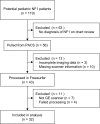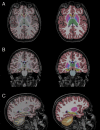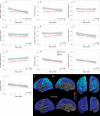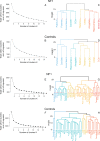Abnormal Morphology of Select Cortical and Subcortical Regions in Neurofibromatosis Type 1
- PMID: 30179114
- PMCID: PMC6209062
- DOI: 10.1148/radiol.2018172863
Abnormal Morphology of Select Cortical and Subcortical Regions in Neurofibromatosis Type 1
Abstract
Purpose To evaluate whether patients with neurofibromatosis type 1 (NF1)-a multisystem neurodevelopmental disorder with myriad imaging manifestations, including focal transient myelin vacuolization within the deep gray nuclei, brainstem, and cerebellum-exhibit differences in cortical and subcortical structures, particularly in subcortical regions where these abnormalities manifest. Materials and Methods In this retrospective study, by using clinically obtained three-dimensional T1-weighted MR images and established image analysis methods, 10 intracranial volume-corrected subcortical and 34 cortical regions of interest (ROIs) were quantitatively assessed in 32 patients with NF1 and 245 age- and sex-matched healthy control subjects. By using linear models, ROI cortical thicknesses and volumes were compared between patients with NF1 and control subjects, as a function of age. With hierarchic cluster analysis and partial correlations, differences in the pattern of association between cortical and subcortical ROI volumes in patients with NF1 and control subjects were also evaluated. Results Patients with NF1 exhibited larger subcortical volumes and thicker cortices of select regions, particularly the hippocampi, amygdalae, cerebellar white matter, ventral diencephalon, thalami, and occipital cortices. For the thalami and pallida and 22 cortical ROIs in patients with NF1, a significant inverse association between volume and age was found, suggesting that volumes decrease with increasing age. Moreover, compared with those in control subjects, ROIs in patients with NF1 exhibited a distinct pattern of clustering and partial correlations. Discussion Neurofibromatosis type 1 is characterized by larger subcortical volumes and thicker cortices of select structures. Most apparent within the hippocampi, amygdalae, cerebellar white matter, ventral diencephalon, thalami and occipital cortices, these neurofibromatosis type 1-associated volumetric changes may, in part, be age dependent. © RSNA, 2018 Online supplemental material is available for this article.
Figures






Similar articles
-
Influences of RASopathies on Neuroanatomical Variation in Children.Biol Psychiatry Cogn Neurosci Neuroimaging. 2024 Sep;9(9):858-870. doi: 10.1016/j.bpsc.2024.04.003. Epub 2024 Apr 15. Biol Psychiatry Cogn Neurosci Neuroimaging. 2024. PMID: 38621478
-
Brain volumes in genetic syndromes associated with mTOR dysregulation: a systematic review and meta-analysis.Mol Psychiatry. 2025 Apr;30(4):1676-1688. doi: 10.1038/s41380-024-02863-4. Epub 2024 Dec 5. Mol Psychiatry. 2025. PMID: 39633008
-
Cerebral volumetric abnormalities in Neurofibromatosis type 1: associations with parent ratings of social and attention problems, executive dysfunction, and autistic mannerisms.J Neurodev Disord. 2015;7:32. doi: 10.1186/s11689-015-9128-3. Epub 2015 Oct 15. J Neurodev Disord. 2015. PMID: 26473019 Free PMC article.
-
Brain morphometry, T2-weighted hyperintensities, and IQ in children with neurofibromatosis type 1.Arch Neurol. 2005 Dec;62(12):1904-8. doi: 10.1001/archneur.62.12.1904. Arch Neurol. 2005. PMID: 16344348
-
Neurofibromatosis type 1: a diagnostic mimicker at CT.Radiographics. 2001 May-Jun;21(3):601-12. doi: 10.1148/radiographics.21.3.g01ma05601. Radiographics. 2001. PMID: 11353109 Review.
Cited by
-
Image-Based Differentiation of Benign and Malignant Peripheral Nerve Sheath Tumors in Neurofibromatosis Type 1.Front Oncol. 2022 May 23;12:898971. doi: 10.3389/fonc.2022.898971. eCollection 2022. Front Oncol. 2022. PMID: 35677169 Free PMC article. Review.
-
Influences of RASopathies on Neuroanatomical Variation in Children.Biol Psychiatry Cogn Neurosci Neuroimaging. 2024 Sep;9(9):858-870. doi: 10.1016/j.bpsc.2024.04.003. Epub 2024 Apr 15. Biol Psychiatry Cogn Neurosci Neuroimaging. 2024. PMID: 38621478
-
Brain volumes in genetic syndromes associated with mTOR dysregulation: a systematic review and meta-analysis.Mol Psychiatry. 2025 Apr;30(4):1676-1688. doi: 10.1038/s41380-024-02863-4. Epub 2024 Dec 5. Mol Psychiatry. 2025. PMID: 39633008
-
Non-Oncological Neuroradiological Manifestations in NF1 and Their Clinical Implications.Cancers (Basel). 2021 Apr 12;13(8):1831. doi: 10.3390/cancers13081831. Cancers (Basel). 2021. PMID: 33921292 Free PMC article. Review.
-
Social Communication in Ras Pathway Disorders: A Comprehensive Review From Genetics to Behavior in Neurofibromatosis Type 1 and Noonan Syndrome.Biol Psychiatry. 2025 Mar 1;97(5):461-498. doi: 10.1016/j.biopsych.2024.09.019. Epub 2024 Oct 2. Biol Psychiatry. 2025. PMID: 39366539
References
-
- Cawthon RM, Weiss R, Xu GF, et al. A major segment of the neurofibromatosis type 1 gene: cDNA sequence, genomic structure, and point mutations. Cell 1990;62(1):193–201. - PubMed
-
- Trovó-Marqui AB, Tajara EH. Neurofibromin: a general outlook. Clin Genet 2006; 70(1):1–13. - PubMed
-
- Payne JM, Moharir MD, Webster R, North KN. Brain structure and function in neurofibromatosis type 1: current concepts and future directions. J Neurol Neurosurg Psychiatry 2010;81(3):304–309. - PubMed
-
- DiPaolo DP, Zimmerman RA, Rorke LB, Zackai EH, Bilaniuk LT, Yachnis AT. Neurofibromatosis type 1: pathologic substrate of high-signal-intensity foci in the brain. Radiology 1995;195(3):721–724. - PubMed
Publication types
MeSH terms
Grants and funding
LinkOut - more resources
Full Text Sources
Other Literature Sources
Medical
Research Materials
Miscellaneous

